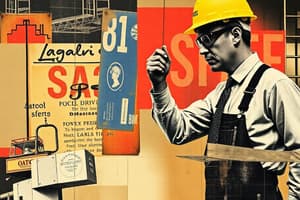Podcast
Questions and Answers
What is fall protection?
What is fall protection?
A system designed to minimize injury from falling when the work height is 6 feet or greater.
What does OSHA stand for?
What does OSHA stand for?
Occupational Safety & Health Administration.
Which of the following is a key element to recognizing hazards? (Select all that apply)
Which of the following is a key element to recognizing hazards? (Select all that apply)
- Hazard Prevention and Control (correct)
- Safety and Health Training (correct)
- Worksite Analysis (correct)
- Management Commitment and Employee Involvement (correct)
What should you do if you experience pain or discomfort as a result of work activities?
What should you do if you experience pain or discomfort as a result of work activities?
What is PPE?
What is PPE?
Danger signs are used only where an immediate life-threatening hazard exists.
Danger signs are used only where an immediate life-threatening hazard exists.
What color represents fire in the NFPA system?
What color represents fire in the NFPA system?
What is Noise-Induced Hearing Loss (NIHL)?
What is Noise-Induced Hearing Loss (NIHL)?
What does a Ground Fault Circuit Interrupter (GFCI) do?
What does a Ground Fault Circuit Interrupter (GFCI) do?
An atmosphere is considered oxygen deficient when the oxygen level falls below 21%.
An atmosphere is considered oxygen deficient when the oxygen level falls below 21%.
What are the fire elements?
What are the fire elements?
What is a Job Safety Analysis (JSA)?
What is a Job Safety Analysis (JSA)?
Study Notes
Fall Protection and Safety Regulations
- Fall Protection systems are crucial for minimizing injury when working at heights of 6 feet or more.
- OSHA stands for Occupational Safety & Health Administration, responsible for ensuring safe working conditions.
- Key elements in recognizing hazards include Hazard Prevention and Control, Management Commitment and Employee Involvement, Worksite Analysis, and Safety and Health Training.
Safety Measures and Equipment
- Personal Protective Equipment (PPE) includes various gear to protect workers from hazards; must fit properly and be comfortable.
- Safety regulations mandate reporting unsafe conditions and wearing appropriate PPE.
- Danger signs indicate immediate life-threatening hazards, while warning signs highlight non-life-threatening risks.
- Caution signs are used to alert against potential hazards or unsafe practices.
Health Risks and Controls
- Bloodborne pathogens include HIV, Hepatitis B virus (HBV), and Hepatitis C virus (HCV), posing significant workplace risks.
- Universal Precautions treat all body fluids as potentially infectious to prevent disease transmission.
Hazard Classification and Communication
- GHS (Globally Harmonized System) is used for classifying and labeling chemicals; ratings range from GHS 1 (most severe) to GHS 5 (least severe).
- NFPA (National Fire Protection Association) uses a color-coded system: Red for Fire, Blue for Health, Yellow for Reactivity, and White for Special Hazards.
Machinery and Electrical Safety
- Understanding machinery types like rotating machinery (e.g., drill presses, saws) is essential for safe operation.
- Arc flashes are dangerous electrical occurrences where current bypasses intended paths.
- Ground Fault Circuit Interrupters (GFCI) protect against electrical shock by monitoring current flow.
Lockout/Tagout Procedures
- Lockout/Tagout practices prevent accidental start-up of machinery during maintenance by using locks or tags.
- Authorized employees perform lockout/tagout to ensure machines are properly shut down and safe for service.
Fall Prevention
- When using ladders, maintain three points of contact to minimize falls; non-self-supporting ladders should use a 4:1 angle ratio.
- Scaffold safety requires qualifications for scaffold users, erectors, and understanding of hazard recognition.
Emergency Response and Preparedness
- In emergencies, provide clear information including incident location, victim count, and potential hazards.
- Everyone has a responsibility to understand and implement the Emergency Action Plan, emphasizing preparedness.
Fire Safety and Chemical Hazards
- Fire requires three elements: Heat, Fuel, and Oxygen; understanding these elements can help in fire prevention.
- Toxic substances can harm health, and pyrophoric chemicals can ignite spontaneously in air, requiring caution during handling.
Noise and Hearing Protection
- Noise-Induced Hearing Loss (NIHL) can occur with exposure over 85 decibels, necessitating hearing protection such as ear plugs and ear muffs.
Studying That Suits You
Use AI to generate personalized quizzes and flashcards to suit your learning preferences.
Description
Test your knowledge on fall protection systems and safety regulations. This quiz covers essential elements such as OSHA standards, hazard recognition, personal protective equipment, and health risks. Understand the key principles of workplace safety and compliance to ensure a safer working environment.




